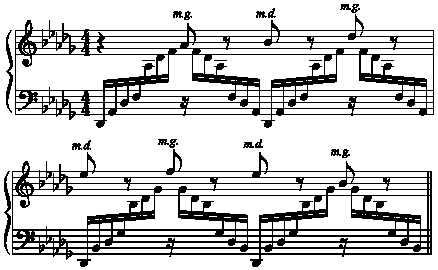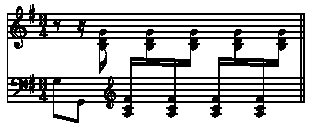
Hand Signs
20.1. As their name implies, hand signs are used to indicate the music played by each hand. (For "Organ Pedalling" see Section 21.) They are placed immediately before the first sign of the passage to which they apply, and the chief details of their use will be found in the various instructions given in Section 28, pages 285-299.
20.1.1. The note following one of these signs must have a special octave mark.
20.1.2. When hand signs immediately precede a sign containing dots 1, 2, or 3, they must be followed by dot 3.
Example 20.1.2-1.
#C4
_>'<"&.>'<"H<J<.F<(EF"J(_>"F<_J<H
<_P'<K

20.2. Passages played with alternating hands should, whenever possible, be written continuously in the part assigned to one hand. It is not always easy to decide which hand is the better for such a passage, but the general layout of the music is the best guide. The following typical examples show different methods of treatment.
Example 20.2-1.
#D%#D4
.>"[ "\]$.$ .:?W<K
_>^:"1^)_G.>_IJ ^$]\%[<>
_>^)_F.>_HJ_>^)E.>_IJ_>^)_FHJ"
_="D.>"FG ^W?:"1_>_=J.>"EG"
_>_=%I.>"FG_>_=J.>"EG<K

Example 20.2-2.
#E<#C8
.>.O<1N"HD.D "TG_J_>'*_FQJ"G.>"J"
.N"HD.D .QD"G_>'*_IT"GJ.>.G<K
_>'U<1^&M ^ZMX&M ^ZMX<K

Example 20.2-3.
#E<#D4
.>'V_>"IX.>"JX_>.EX .>.FX_>.GX"
.>.FX_>"JX<K
_>_7_7'^ZI_EG.>_I"EGMGE_I_>_GE^I7
^Z^JEH.>_JEH_7'MHEJ_>_HEJ7<K

20.3. When a passage divided between the hands contains the complete text it can be treated in one of two ways according to the disposition of the score.
(a) If the music is written "section-by-section" [see Par. 29.1], such a passage will appear as in the above examples, essential rests being placed in the part not occupied by notes (preceded by dot 5 where they are additional to the print);
(b) If the music is written in parallel disposition (see "Bar-over-Bar", Par. 28.1 ff.) it is only necessary to use one parallel for the two hands, and no unessential rests need be included.
Example 20.3.1-1.
%#C4
_>_(.>_JDE&_>"GHI).>.DEF ">SIM'"
_=IJDZFGH!JDE _&HIJYEFG(IJD
_>_Z.>.DIGZ_>_IGE.>^Z_>"DJI<K

It is possible that such a passage may include here and there notes for which the in-accord sign is needed. Care must be taken to mark clearly the hand to which such notes are assigned.
Example 20.3.1-2.
#D4
.>.QFEDTIHG_>"PEDJ.>.RGFE"
.QFEDTIHG_>"PEDJ@C.K.>.O"IHG"1
_>_J .>"PH.D"H"1_>"D.K.>"PHF_J"
"NFD_H_>_PHFD<K

20.4. When a passage containing intervals alternates between the hands, the intervals are always read in the direction which prevails in the part in which the passage is written.
Example 20.4-1.
(intervals read downward)
%#C4
.>'XM"(##00_>"=.>"H_>"G.>"H"
">SIM'"=HGH#0<K
_>_H^H"V"V<K

20.4.1. When chords are divided between the hands, the hand signs should be so placed that there can be no mistake about which hand plays which notes.
Example 20.4.1-1
#E<#D4
A .>'VV.[9-_>'+.>.]+0_>'+
_>^Z9
B .>'V.W90_>'-.>.R#0_>'-<K
_>^Z9<K

20.5. In print music for teaching, the indications "M.D." (main droite) and "M.G." (main gauche) are sometimes found. In facsimile transcriptions these should always be transcribed even when braille hand signs are used:
|
M.D. |
>M'D' |
M.G. |
>M'G' |
The Sustaining Pedal
20.6. The print "ped." and star (or asterisk) indicating the depression and release of the sustaining pedal are represented in braille by the signs shown in Table 20 (B). These signs must be placed exactly where they occur in the print, and, as they are printed below the bass staff, it is usual to include them in the left-hand part in the braille text, though there will be many instances where an exact indication of the pedalling is only possible in the right-hand part, e.g., where the left hand has a measure of silence or a long note during which the pedalling is changed.
The down and up signs should be considered as a more or less inseparable pair, and if one appears in the right-hand line it is desirable that the other should also. An exception would occur if the pedal were depressed during a measure in which all of the music had to be shown in one hand line of the parallel, while the corresponding release occurred in a measure in which all of the music had to be shown in the opposite hand line.
20.7. The rules for the marking of pedalling are as follows:
20.7.1. The sign for the depression of the pedal is placed before the note or rest indicated, and must precede the bracket slur and any of the signs in Tables 5, 7, and 18 which are placed before notes. If the pedal is to be depressed immediately after the note or chord is struck, however, the modified pedal-down sign (dots 6, 126, 14) should precede said note or chord.
20.7.2. The sign for the release of the pedal must follow the note, interval or rest indicated, or any signs in Table 9, and 11-14 which are placed after notes or intervals.
20.7.3. If the pedal is to be released immediately after a note or chord is struck, however, the modified pedal-up sign (dots 6, 16, 14) should be brailled preceding the note to indicate this particular execution.
Example 20.7.3-1.
#C4
_>'<C>P>C.8^?_\#0*CXH<+0
<C>F_]<+<0-,8<^E<-XV<L*C<K

Example 20.7.3-2.
<#B4
CI .>'M>MF"DCECD7
_>'<C>MF_]+,*C]<+<K

20.7.4. When the pedal is depressed immediately after it has been released, the sign for its release is not used. It is not necessary to mark the release of the pedal before a double bar. However, the final pedal release should be included if it occurs before a final rest or any place other than at the double bar.
Example 20.7.4-1.
#C4
_>'<C>P>C.8^?_\#0<C\<+0
<C>F_]<+<0-,8<^E<-*CXV<L<K

It sometimes happens that "ped." and a star are both printed below the same note or rest; the braille equivalent for this will be found in Table 20.
20.7.5. (11-97) Such directions as "con ped." are always transcribed as they stand, and when "ped." is not followed by a star at any subsequent point it is better to write "(ped.)" with the word sign before the parenthesis. See Par. 18.8.2.
20.7.6. Pedalling is frequently indicated in modern print editions by a horizontal line (sometimes a line of dots) marked "p" printed below the bass staff; the release of the pedal is shown by a break in the line, the end (or an arrow) being turned up towards the staff. Half-pedalling is indicated by bending this line in an inverted V towards the staff.
The signs given in Table 20 (including that for half-pedalling) are used to represent this device, a note describing the print usage being inserted in the braille text.
Example 20.7.6-1.
#D4
_>'<C@(-.C<>U^T+0 7<L<>
"<C_N<+%#0"<CO*+0<L<K

Pedalling and Repeats
20.8. When a passage is repeated, and the pedal is depressed at any point during the original and held during the repeat, the repeat sign may be used.
Example 20.8-1.
#D4
(print)
<C_YFH"D&D_HFYFH"D""&D_HF*C<K
(braille)
<C_YFH"D&D_HF7<K

Example 20.8-2.
#D4
(print)
_YFH"D<C&D_HFYFH"D""&D_HF*C<K
(braille)
_YFH"D<C&D_HF7<K

20.8.1. If in such a passage the pedal is used twice without a break, first for the original and then for the repeat, it must be re-marked before the repeat.
Example 20.8.1-1
#D4
(print)
<C_YFH"D&D_HF<CYFH"D""&D_HF*C<K
(braille)
<C_YFH"D&D_HF<C7<K

(N.B. The reader must be warned against such a passage as the following:
Example 20.8.1-2.
#D4
<C_YIH"D<C&D_HFYFH"D"
"&D_HF*C<K

where the use of the part-measure repeat would give the impression that the pedal is again used on the fourth beat of the measure.)
20.8.2. If the pedal is only used during part of the original passage and the repetition is exact, the repeat sign automatically includes the pedalling.
Example 20.8.2-1.
#D4
(print)
<C_YFH"D*C&D_HF<CYFH"D*C""&D_HF<K
(braille)
<C_YFH"D*C&D_HF7<K

Example 20.8.2-2.
#D4
(print)
_YFH"D<C&D_HF*CYFH"D"<C"&D_HF*C<K
(braille)
_YFH"D<C&D_HF*C7<K

20.8.3. If the pedal is only depressed for either the first or second half of such a measure, the repeat sign may be used so long as the pedalling is made perfectly clear.
Example 20.8.3-1.
#D4
(print)
_YFH"D&D_HF<CYFH"D""&D_HF*C<K
(braille)
_YFH"D&D_HF<C7<K
Example 20.8.3-2.
#D4
(print)
<C_YFH"D&D_HF*CYFH"D""&D_HF<K
(braille)
<C_YFH"D&D_HF*C7<K
With regard to the measure repeat, Paragraphs 20.8.1 - 20.8.3 above apply to a passage of two measures, in which the second is a repetition of the first. It is unnecessary to give the "print" versions of the following examples.
Example 20.8.3-3. (Par. 20.8)
#C4
_>'<C_?$+7 7<K

Example 20.8.3-4. (Par. 20.8.1)
#C4
_>'<C_?$+7 <C7<K

Example 20.8.3-5. (Par. 20.8.2)
#C4
_>'<C_?$+*C7 7<K

Example 20.8.3-6. (Par. 20.8.2)
#C4
_>_?<C$+7*C 7<K

Example 20.8.3-7. (Par. 20.8.8.3)
#C4
_>_?$+7 <C7<K

Example 20.8.3-8. (Par. 20.8.3.)
#C4
_>'<C_?$+7 *C7<K

(Note that it is more suggestive to place the sign for the release of the pedal at the beginning of the second measure in the last example.)
20.9. When several measures are repeated, and the pedal is changed between the measures, the measure repeat may be used, the signs for the depression and release of the pedal being marked where necessary; but great care should be exercised in this combination of pedalling signs with repeats, and it is better to sacrifice the repeats when there is any possibility of confusion or error.
Example 20.9-1.
#C4
(print)
_>'<C_?$+$+ _?$+$+*C_?$+$+ <C_?$+$+ _?$+$+*C<K
(braille)
_>'<C_?$+7 7*C 7 <C7 7<K![]()
20.10. It is extremely difficult to provide adequate rules for all possibilities, and if any doubt should arise as to the application of the rules given in Par. 20.8-20.9 to particular cases, the repeat sign should not be used.
20.11. Partial abbreviation, the segno, and braille da capo, and repeats with measure numbers, can only be used when the pedalling is exactly the same as that in the original passage.